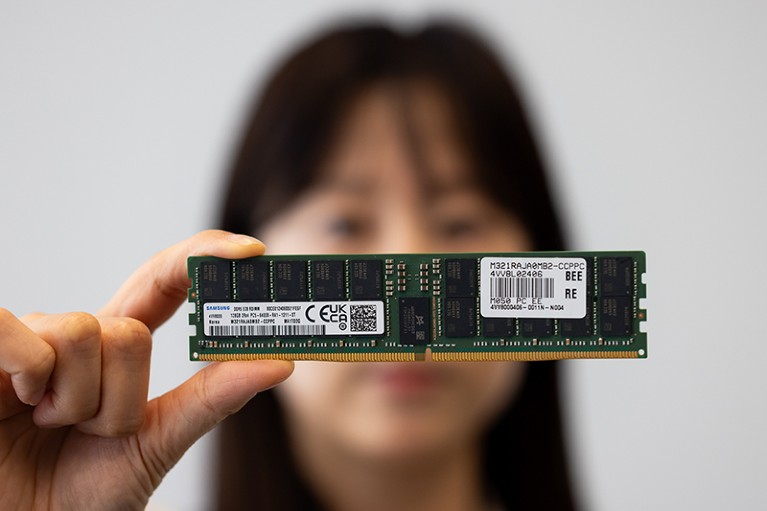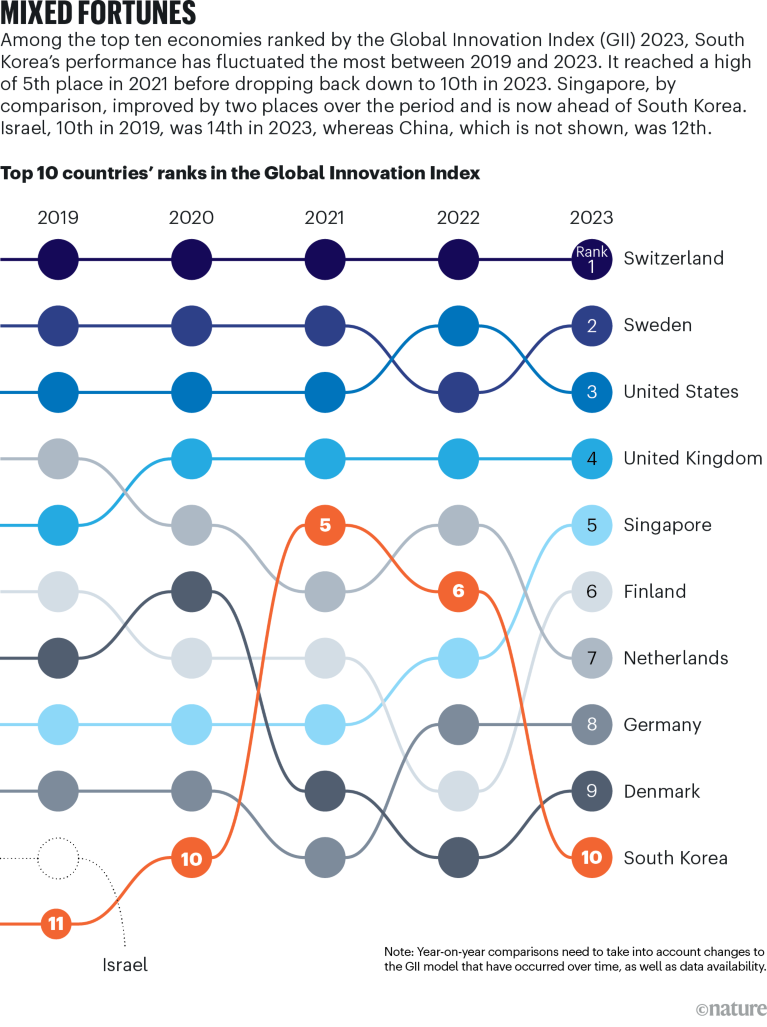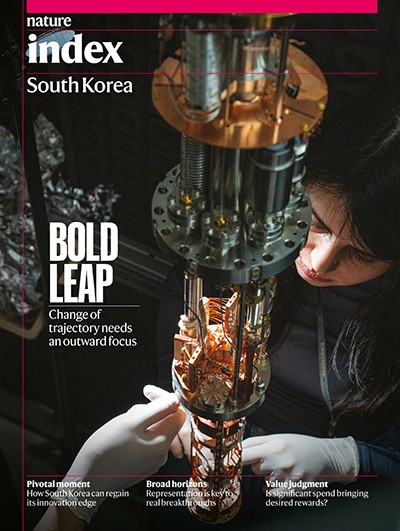South Korea’s reputation as a leading innovator is under threat. In a benchmarking report released by the country’s Ministry of Science and ICT in February, South Korea had slipped behind China in science and technology development for the first time. The report analysed research papers, patents and expert surveys in 11 technology areas, including information and communications technology, defence and nanoscience.
Such performance metrics are taken very seriously in South Korea, says Martin Hemmert, a global business researcher at Korea University Business School in Seoul. “This kind of benchmarking is a national obsession, and they will always find a data point telling them they’re not doing well enough,” he says. The report showed that South Korea had continued to close the technology gap to the United States, but being surpassed by China in the ranking was what made national headlines.
Nature Index 2024 South Korea
“Koreans themselves would tell you that they’re not very good at R&D — even though, from an international perspective, the country is obviously a stellar performer,” says Sung-Young Kim, a political scientist at Macquarie University in Sydney, Australia, who studies the role of government in East Asia’s economic transformation. For a country that has achieved remarkable economic development, a slowdown, especially compared with its competitors, is a source of anxiety for many South Koreans.
In the wake of the Korean war, which split the country into the Soviet-influenced north and the US-influenced south in 1953, South Korea was one of the world’s poorest and least developed nations. From the early 1960s, its strategic focus on manufacturing and export fostered a period of rapid economic growth referred to as the Miracle on the Han River. By 2018, South Korea’s GPD per person measured at purchasing power parity — a metric that adjusts GDP to account for price differences between countries — surpassed that of Japan. “South Korea has become famous for mobilizing science and technology for industrialization and economic advancement,” says So Young Kim, a science and technology policy researcher at the Korea Advanced Institute of Science and Technology (KAIST) in Daejeon.
Yet signs that the country is losing momentum are hard to ignore. In the 1980s, South Korea’s compound annual growth rate of GDP per person reached almost 12%, but had slowed to 7.2% in the 1990s, 4.8% in the 2000s and 2.4% in the 2010s. This figure has since stabilized while remaining below that of other advanced economies, including Canada and Italy. “We have been growing slower and slower, and the government is quite worried,” says So Young Kim, who was appointed to chair a presidential commission in March, to propose solutions. “The new administration has been trying to revamp policies, institutions and funding structures to regain strength in science and technology, so that we can have another Miracle on the Han River.”
Picking winners
South Korea’s history has had a big impact on the national psyche, especially its development of innovative military technology, says Sung-Young Kim. “It forged this mentality that technology is a source of national security,” he says. The government designated strategic growth areas and pooled the nation’s limited public and private resources to enable the change. Information and communications technology was one such priority area. Today, South Korea is a leader in fast broadband and next-generation mobile communications, but 50 years ago, there was an 18-month wait to connect a phone to the country’s antiquated network, says James Larson, who arrived as a peace corps volunteer in 1971 and now studies digital development at the State University of New York Korea, a campus of the US university located in Incheon.
To achieve development and growth in telecommunications and other priority areas, buy-in from the corporate sector was crucial. “The key incentive for companies that participated in state projects was the potential to completely dominate an industry,” says Sung-Young Kim. The strategy catapulted a handful of companies, including Samsung and Hyundai — originally a food exporter and a local construction firm, respectively — into some of the world’s most successful conglomerates. But funds were never given freely. “The government would attach monitorable performance outcomes, and the president would sit in on meetings and stipulate targets for companies,” says Sung-Young Kim. During South Korea’s period of military rule, from 1961 to 1993, repercussions for missed targets ranged from being cut from further funding to jail time imposed for company bosses whose performance lagged.
The methods that today’s democratically elected South Korean government uses to support economic development have evolved, but the philosophy of strategic investment tied to detailed performance metrics remains. The question now is whether such an approach can deliver the same results when the companies that were once propelled by government funding and projects have become global behemoths that are not so easy to influence.
Manufacturing, meanwhile, is more reliant than ever on international supply chains, which are increasingly vulnerable. The COVID-19 pandemic and Ukraine and Gaza wars have created challenging conditions for South Korea’s export-oriented economy, as have heightened tensions between China and the United States. “With the US–China trade war, South Korea is again sandwiched between two great powers and finds that the only way it can really survive is, again, by digging into its strength in technological development,” says Sung-Young Kim.
Leveraging the innovation capacity of South Korea’s well-funded academic research is a strategy worth pursing, according to a report published by the Organisation for Economic Co-operation and Development (OECD) in 2023 (see https://doi.org/m8q9). But the government’s characteristic approach of prioritizing sectors and micro-managing the research it funds doesn’t necessarily foster innovation in the academic sector, says Hemmert, who contributed to the report.

A Samsung high-capacity DRAM module. The firm is integral to South Korea’s fortunes.Credit: SeongJoon Cho/Bloomberg via Getty Images
Another issue is that many people in South Korea are uncomfortable with the idea of providing ongoing public funding for researchers to pursue long-term goals, which makes it difficult for the government to secure support for such measures, says Sung-Young Kim. “This is a performance-based culture, so it has been difficult for people to accept that the government should be putting money into basic science” rather than more commercial areas, he says.
In 2022, the government chose to focus its research investment on 12 strategic technologies, including semiconductors and electronic displays, artificial intelligence, aerospace, cybersecurity and hydrogen. “It is the very typical government strategy of picking winners to make the most efficient use of our resources,” says So Young Kim. For researchers working in these areas, concentrating resources on their development is important for keeping up with rivals — particularly considering China’s rapid development, she says. But others in the academic sector argue that focusing funding too narrowly means neglecting areas of research where unexpected breakthroughs might arise. “Among our young researchers there is concern over whether fundamental research will be ignored because it doesn’t bring immediate benefits,” she says.
Strategic goals
Regardless of the work being funded, a more fundamental issue that is stifling innovation in research is the short-term nature of funding. “Our funding programmes are usually very short, typically one or three years,” says So Young Kim. Mid-term performance milestones are set and a heavy emphasis is placed on measuring output in terms of top-tier journal publications and patent registrations, she adds. “If you are not successful in the current programme, there’s no way to continue your research, because new funding is based on past records.” The funding structure forces researchers to focus on quick wins.
“For really cutting-edge research, you need a more patient approach,” says Hemmert. He adds that research in Japan — where the same topic can be pursued for decades in multi-generational labs — offers an interesting point of reference. “Japanese scientists have picked up a good number of Nobel prizes, but South Korea has zero,” says Hemmert. “When I looked at the profiles of Japanese Nobel scientists, they typically worked on some specific scientific problem for decades.”
Creating tailored programmes for funding science with the potential to be paradigm-shifting was a key recommendation of the OECD innovation review. “Of the many people we interviewed, many understood the need to support more high-risk, high-return research, and some in positions of influence were starting to work on it,” says Hemmert. But the level of change required has not been fully appreciated, he adds. For example, South Korea’s leading universities are highly regulated and lack autonomy. The government has designated some as ‘research universities’ — including Seoul National University (SNU) and KAIST — that receive more funds, “but instead of just leaving these well-resourced institutions alone to set strategies, there are still a lot of rules”, says Hemmert.

Source: Global Innovation Index Database, WIPO, 2023
The government has improved ties between academia and industry. Conventionally, R&D in the close-to-market technologies that the South Korean government has thrown its weight behind is seen as being more within the remit of government research institutes than of universities. But since about the year 2000, the government has sought to boost knowledge flows from universities into industry, such as by permitting universities to create for-profit spin-outs, and by focusing on public–private partnerships. SNU, for example, has active participants in many research, development and demonstration projects in the green-energy industry, says Sung-Young Kim.
Although the country’s research universities often rank highly in industry–academia linkage metrics such as patents filed and spin-outs launched, there’s room for improvement, says Hemmert. “They understand the need to collaborate more, yet when it comes to implementation, it’s still a bit chequered.”
Social shifts
Promoting high-risk, high-return research is a good strategy, but there are many social and cultural considerations to account for. South Korea has the world’s lowest birth rate, and its ageing population is putting increasing pressure on the health-care system. Previously, when science, technology and innovation were the government’s focus, the brightest students were drawn to disciplines such as engineering, says So Young Kim. Nowadays, they pursue medicine, because it’s a secure, well-paid and prestigious career with strong government support. In February, the government announced an increase to the national medical school intake quota from around 3,058 places — a number that has remained fairly consistent since 2006 — to 5,058 from 2025. “The top students are already choosing medical fields first, so by increasing the quota, what’s going to happen to science and technology student enrolments?” says So Young Kim. Even at SNU, the leading South Korean institution in the Nature Index, “their engineering programmes have a hard time recruiting students from their own undergraduate programmes”, she says.
Recent policy changes have exacerbated this problem. In 2023, the South Korean government announced a cut to R&D funding by 16.7%, later winding it back to 14.7% after a widespread criticism. R&D spending remains at approximately 5% of GDP, which is far above the 2.8% OECD average, and some targeted cuts to certain programmes is probably warranted, Hemmert says. But the way the cuts were implemented to basic funding has a disproportionate impact on young researchers, says So Young Kim, because student and postdoc stipends come directly from a professor’s own funding.
The government is considering other options for encouraging young people into science, such as expanding a programme that allows men to serve out their 18–21-month-long mandatory military service by continuing to work in their university labs. “The bigger challenge, I think, is not how we design these extra benefits, but how we make studying science and technology a really fulfilling experience for those who are interested in it,” says So Young Kim. She says that students and early career researchers often feel as though they are stuck doing manual labour in the lab, rather than being taught how to conduct research, which can be very unrewarding. “We need to find that intrinsic motivation for our students. Professors need to become role models, demonstrating that through this career we live a meaningful life,” says So Young Kim.
South Korea has an uphill battle ahead of it if it wants to regain its lead in technical innovation, but its historic ability to pivot in response to dramatic changes stand it in good stead, says Hemmert. “It’s a question of understanding what needs to be done, and then having the right leadership to implement the change.”


